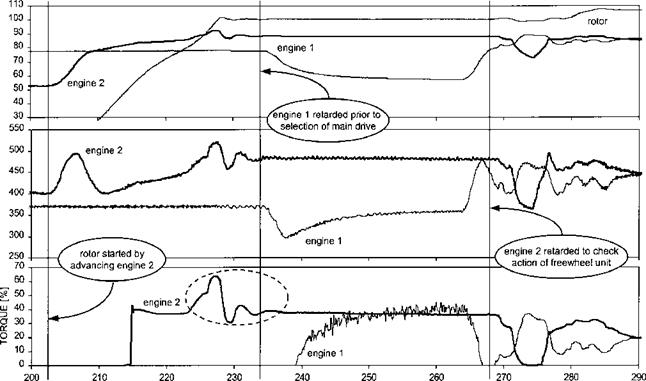Engine(s) and rotor starting
Tests are made to assess the procedure for starting the engine(s) and engaging the rotor; this will include determining the starting envelope. Eventually, successful engine starting will have to be demonstrated throughout the anticipated operational range of environmental temperatures. Tests include internal battery starts of cold-soaked engines and restarts of engines with high residual temperatures. The airborne re-light envelope and recommended airspeed are also established for each engine in a multi-engine aircraft. This re-light envelope is often smaller than the aircraft operational flight envelope as at high altitude there may insufficient air density to windmill the engine properly or insufficient oxygen to ensure adequate ignition. The drain on the electrical system caused by starting an engine can sometimes result in other aircraft systems being affected, for example, the AFCS can drop out, lighting circuits can be switched off and navigation systems can close down. For normal ground starts none of these effects may matter as the engines are usually started before these systems are engaged, however, for airborne starts the implications may be serious and must be investigated.
The starting sequence is assessed to determine if the actions required of the pilot are easy to perform and the order is logical. Many engine starting sequences are extremely complex and require a high degree of concentration, although with the advent of FADEC systems this problem has become less common. In addition to a subjective opinion on the starting process, quantitative data is collected on time to light-up, rate of oil pressure rise, and the temperature rise profile. This data is normally presented in reports in the form of time histories and an example is shown in Fig. 7.6. The maximum rate at which the rotor can be accelerated to the normal operating RPM is found by incrementally increasing the rate at which the throttle is advanced until a limiting condition is reached. The total time required to complete a start from commencing the pre-start checks to being ready for take-off is also established; for certain roles, such as search and rescue, air ambulance and special forces operations, this time may be a major factor in determining the acceptability of the aircraft.
|
|
|
|

The engine and rotor shutdown procedure is also assessed to determine if it is easy to perform. The lack of a rotor brake or an inefficient one may constitute a deficiency in some roles where having the rotor turning for prolonged periods at low RPM may create a hazard to the aircraft or personnel. In addition, any requirement for long engine cooling periods at ground idle may be considered a deficiency.











